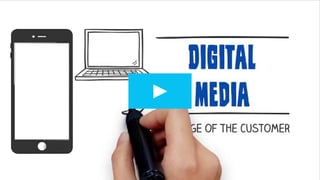2 Ways to Empower Your Sales Staff in the Age of Digital Media

The following article was originally published on Channel Rocket's blog. It's been updated in June of 2017 with fresh content.
The sales landscape has changed dramatically in recent years with the proliferation of available information online. The mobile, technology-driven world we live in has changed the way we do business on every level. As sales professionals, we need to be keenly aware of how the changing landscape affects the way our prospects make purchase decisions.
The amount of new technical information is doubling every two years and 95% of all of the data in the world has been created in the last two years! - (Courtesy of Rick Bates via Main Broadcast Coalition)
With the ability to access information at any time, from any place the game has changed for businesses trying to compete for consumers looking to buy. Gone are the days of potential buyers relying solely on sales people for information on our products or services. As an example "shopping" for cars is often performed online, rather than a dealership.
89% of US internet users search online before they make a purchase, even when that purchase is made at a local business - (Courtesy of HubSpot)
To maximize your team’s potential and production, focus on the following two areas of empowerment. As you equip your team with dynamic sales tools you'd be wise to also provide them resources for competing in the digital age as thought leaders. By implementing, you’ll empower your sales staff with effective methods of answering questions, presenting features and benefits, supporting their claims, and building credibility. If you're able to achieve sales and marketing alignment, your entire team will be involved and connected through the entire buyer's journey. Understanding the role of both marketing resources and technology can help you empower your sales team to solve in today's digital atmosphere.
Build a Dynamic Set of Interactive Sales Tools
A Power Point bound in a spiral notebook isn’t dynamic. Sending email after email with no idea if it’s being opened or not is so 1998. In today’s digital world we have amazing sales support software platforms available to us. They enable sales to be more efficient, informed, and effective than ever before. The ability to integrate different software solutions like Salesforce, Sidekick, and Channel Rocket allows sales professionals the complete toolset needed to perform to their potential.
Here’s a list of capabilities your sales team should already have the ability to do:
- Harvest valuable insights, contact information, and company statistics.
- Share the most relevant presentation materials, instantly, with a touch of a button.
- Track every email, link, and document for real time engagement and user statistics.
- Seamlessly sync data between your sales and marketing teams.
- Connect buyer pain directly to your solutions with carefully mapped messaging.
- Create and access interactive sales and marketing assets from any mobile device.
- Connect influencers with decision makers directly to your sales documents.
- Access detailed analytics on the materials that interest prospects the most.
The ability to give your sales team these capabilities relies on the software solutions you choose and requires you to set them up to work together. When integrated, the buyer’s journey can be enhanced by the list above. The result is an empowered sales team ready to execute effectively on every opportunity.
Build an Incredible Online Library of Information & Resources
The Age of the Customer has shifted the decision making process from the salesperson to the prospect. This shift requires businesses to take a closer look at their online presence in whole. If we want to empower our sales staff for success we need to present well, present everywhere, and stay front-of-mind. We should consider a cohesive strategy that puts our message in front of prospects as much as possible across a wide digital footprint. Here are some steps to consider:
- Build a website that speaks directly to your prospects, educate them on your services, and confirm sales claims.
- Publish resourceful whitepapers, case studies, and articles that inform potential customers.
- Build a social community that provides your customers a platform to provide feedback and your prospects a history of your service record.
- Develop an email strategy that provides a steady source of resources to nurture prospects to maturity.
- Manage everything through the right marketing automation software, track everything, and make continual adjustments for improved results.
Putting everything together into a harmonious echo system might seem like a wild dream, but it’s not. There are organizations like mine that build digital marketing strategies and work through complex software integrations. Whether you have a couple questions about the various technologies I mentioned in this article or want to talk strategy in general I’m always eager to make new friends. Look me up.

